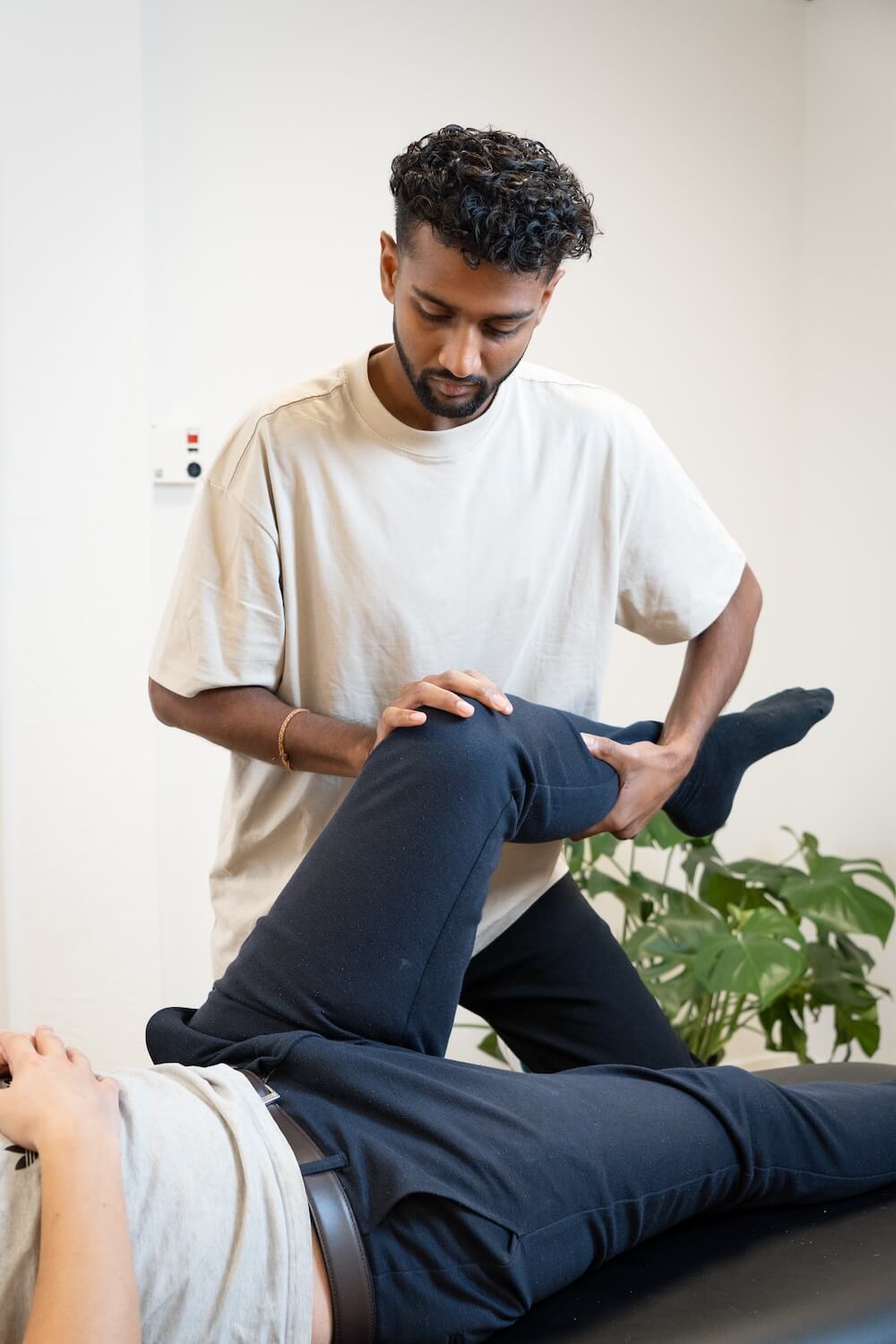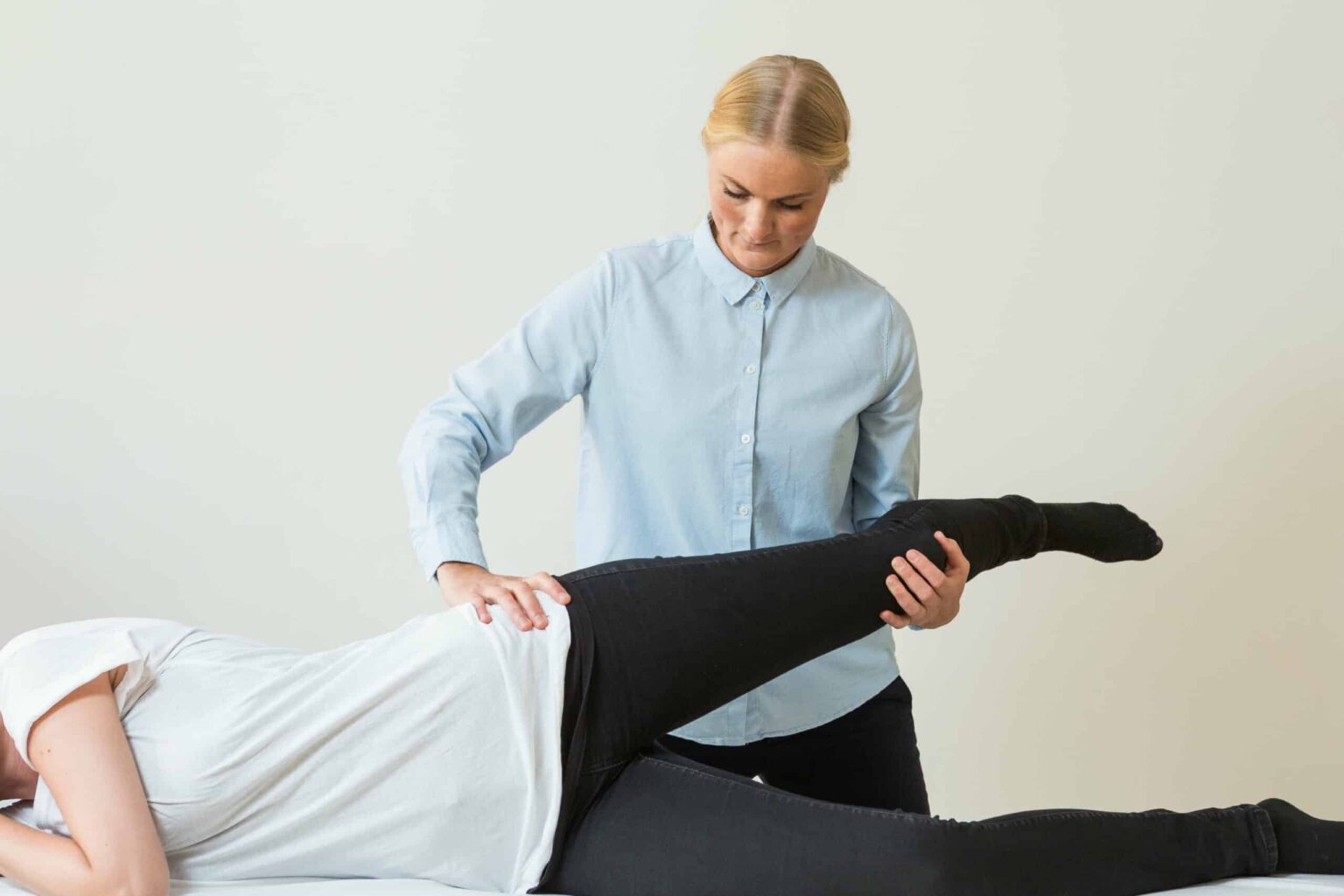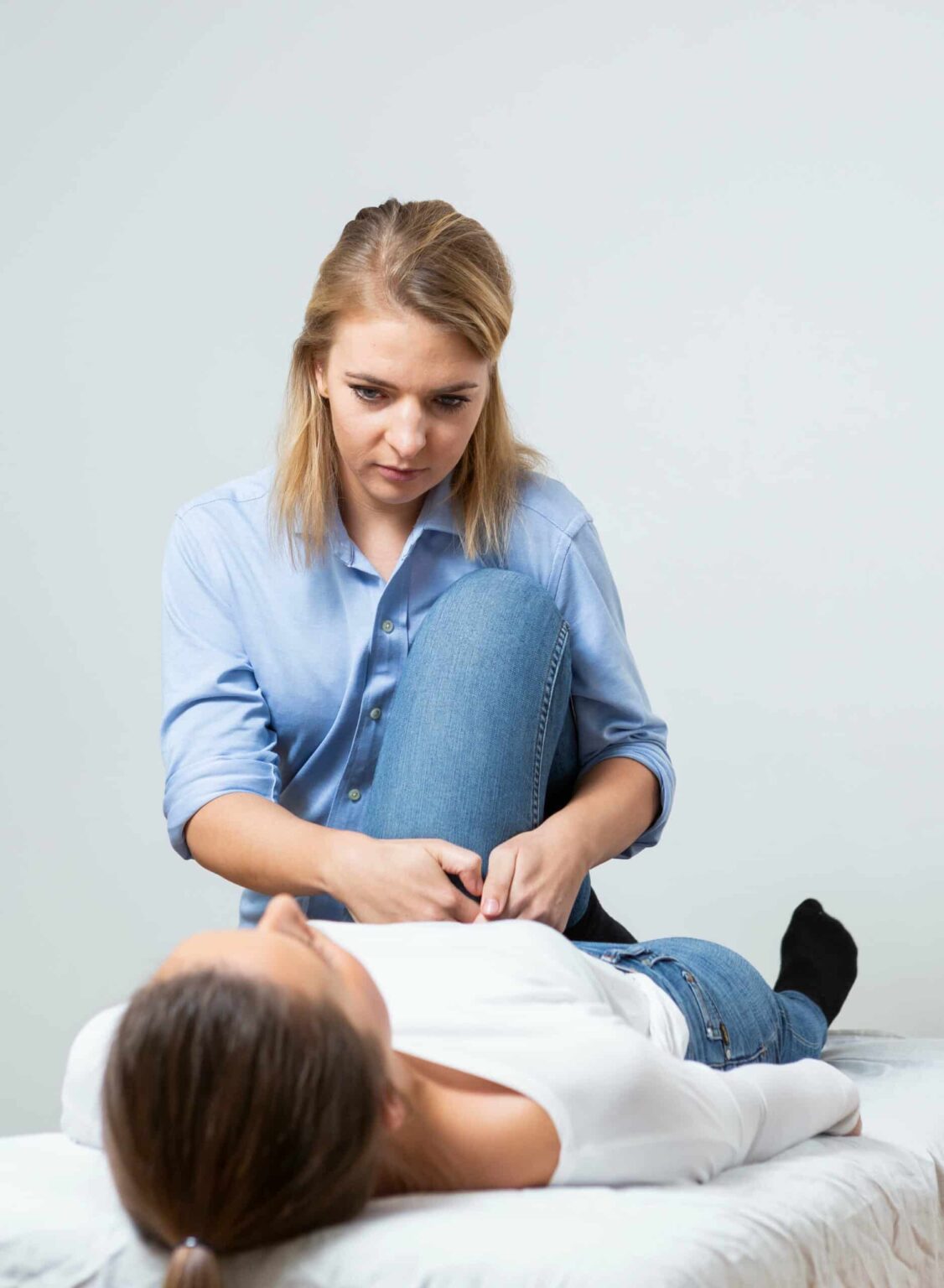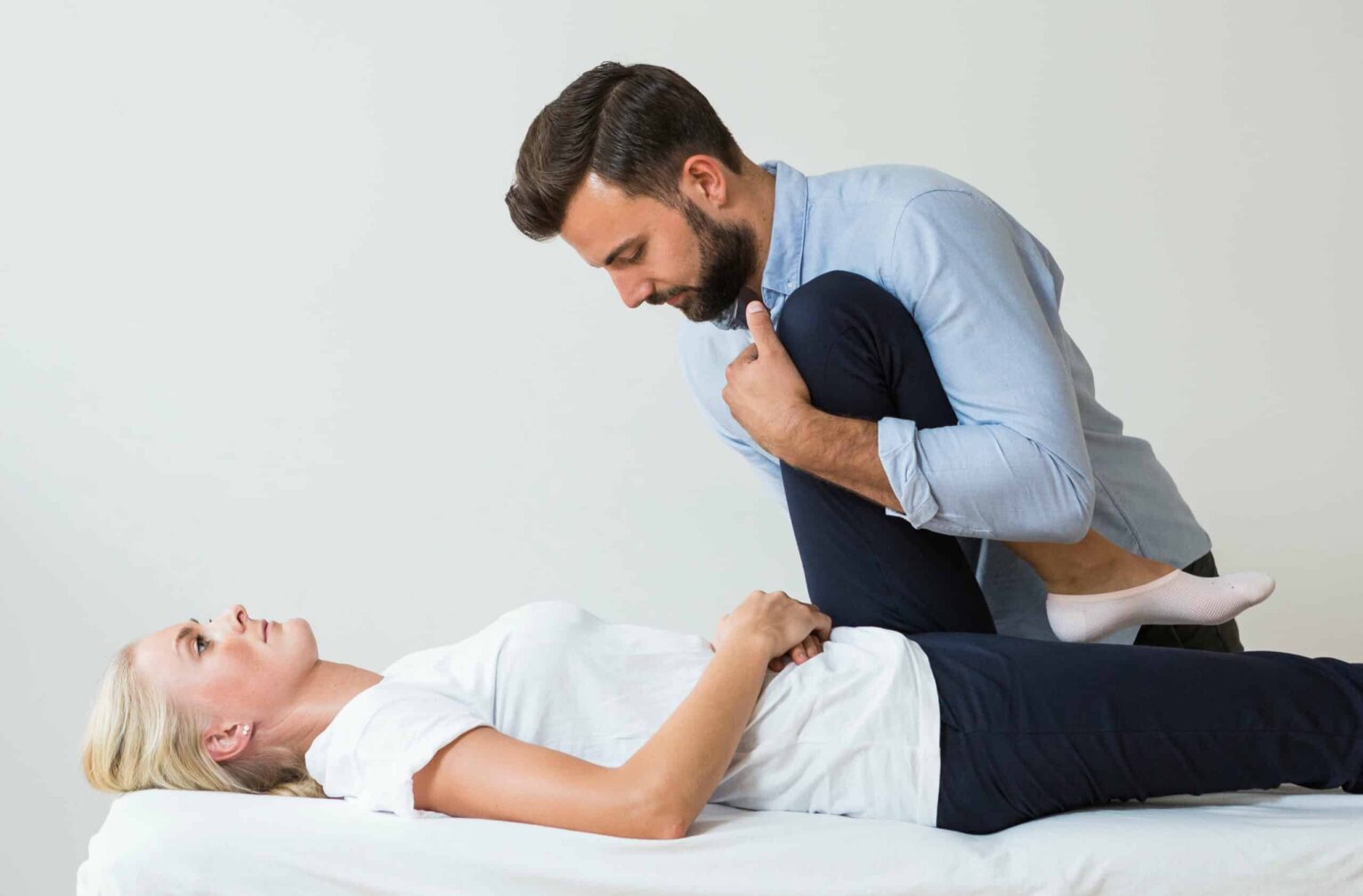We treat
Pelvic pain
Pelvic pain? Let us help
What is pelvic pain?
Pelvic pain is often described as pain between the lumbar spine and our thigh bone. Here it can be located in various places, such as the lower back, symphysis pubis, groin, front of the thigh, outer hip, tailbone, buttocks and our SI joint. This pain can occur during stress, such as walking, certain work positions, climbing stairs, getting up or sitting down, getting in and out of a car, as well as rotational movements. In some cases, pelvic pain can also be experienced while resting.
Jump to section [Vis]
How is the pelvis structured?
Our pelvis is composed of multiple bones. “Os” is the Latin term for bone.
The bones of the pelvis
We have the following bones/bone parts:
- Os sacrum = sacrum
- Os ilium = ilium/hip bone
- Os pubis = pubic bone
- Os ischium = ischium/sitting bone
- Os femur = femur/thigh bone
Os ilium, os pubis, and os ischium are actually part of the same bone!
Joints in the pelvis
The pelvis contains several joints, the first being between the lower part of the spine and the sacrum, known as the lumbosacral junction. Additionally, we have:
- The SI joint (sacroiliac joint) between the sacrum and ilium
- A joint between the two pubic bones, called the pubic symphysis
- A joint between the hip bone and the thigh bone
Nerves in the pelvis
The pelvis contains numerous nerves that help innervate the organs in this region, as well as the muscles in the abdomen, pelvis, and legs.
Key nerves that pass through the pelvis
- Femoral nerve
Issues with this nerve due to root compression, inflammation, or restriction can cause lower back pain (Lumbosacral plexus, levels L2-L4), as well as sensory disturbances and pain in the front of the thigh, inner thigh, inner lower leg, and foot. This nerve is also connected to the hip flexors and knee extensors. - Lateral femoral cutaneous nerve
Problems with this nerve can cause discomfort in the lower back (Lumbosacral plexus, levels L3-L4), front and upper pelvis, groin, and outer thigh. Sensory disturbances related to this nerve often manifest on the outer side of the thigh. - Sciatic nerve
Also known as nervus ischiadicus in Latin and sciatic nerve in English. Issues with this nerve can often lead to pain in the lower back, posterior pelvis (Sacral plexus, levels L4-S3), buttocks, back of the leg, and sometimes down to the foot. - Obturator nerve
This nerve is located deep within the pelvis and is often associated with mid-lower back pain (Lumbosacral plexus, levels L2-L4), deep pelvic pain, and pain in the inner thigh.
What causes pelvic pain?
There can be many causes of pelvic pain, but below we will review a few examples.
Overload and overuse issues
Pelvic pain can be caused by overload, which occurs by exposing the joints to excessive weight load in movements, typically in connection with sports or accidents such as falls and impacts.
Similarly, repetitive or incorrect movements, such as poor walking patterns or working positions, can lead to “overuse”.
Poor posture can also disrupt pelvic alignment and cause pain. Osteopathy focuses on improving posture to help the pelvis and body heal itself.

Muskuloskeletale system og ubalancer
The hip and pelvis contain several joints that must move in different directions because of the musculoskeletal system. Muscles contract to perform movements on the bones they are attached to, and relax when the work is done.
In the pelvic area, muscular balance is crucial, including the relationship between the front, back, outside and inside, and the right and left side.
Pain problems can also be caused by excessive muscle growth or activity, which can press on nerves and blood vessels and cause local or radiating pain, such as tingling, stabbing, or buzzing pain.
Reduced mobility and restriction in joints
Reduced mobility or locking in the knees, hips and back can also cause joint problems in the pelvis. This also applies to the local joints in the pelvis if any of the nearby joints do not move optimally.
An example of this could be if a joint has reduced mobility in one place, then it can cause pain locally in the joint. Having reduced mobility or a restrictive joint is also called “hypomobility” (note that this is the opposite of hypermobility).
In addition, a restrictive joint can also cause pain in nearby joints, as these are put on overtime if they have to work extra hard due to reduced movement or restriction elsewhere.

Organ system
The pelvic area contains several organs and is surrounded by several membranes. These membranes are joined together by fluids and must be able to slide easily between each other. Several of these membranes are attached to the pelvic bones.
If scar tissue or inflammation occurs over a long period of time in the organ system, it can affect the sliding between the membranes and thus also the function of the pelvis.
Likewise, the large intestine is attached to the inside of the pelvic bone, and conditions such as appendectomy, irritable bowel syndrome, and other gastrointestinal problems can affect the physiology of the intestine.
This can cause tension in the tissues of the pelvis and affect structures such as the hip flexors, pelvic bone, inguinal nerves, and more.
The circulatory system and the diaphragm
The heart helps pump blood out to the periphery, but the heart also rests on the diaphragm, also known as the middle floor, which is the body’s pump and crucial for the movement of the organs.
The diaphragm acts as a piston and helps with blood flow in the circulatory system. Obstructions such as scar tissue and adhesions can impair function in local areas. Lack of arterial blood supply to an area can lead to oxygen deprivation and pain.
Venous reflux can lead to waste accumulation and increased pressure, which can develop into inflammation, bloating, or pelvic pain as possible outcomes. In rare cases, varicose veins, thrombosis, and arteriosclerosis can occur, leading to reduced blood circulation and pelvic pain.

Psychosocial and neurological aspects
Symptoms may be similar between individuals, but the etiology of the pain varies due to various factors.
Pain conditions can in some cases result in chronic conditions such as CRPS, chronic fatigue syndrome and/or kinesiophobia, which are associated with depressive and anxious reactions that complicate life with a chronic condition and create a spiral that can be challenging to break.
In addition, there is our nervous system, which is intimately connected to our mental state.
The nervous system and pelvic pain
The nervous system is divided into the central nervous system, including the brain and spinal cord, and the peripheral nervous system, which extends from the brain and spinal cord to the rest of the body.
The autonomic nervous system, which we do not directly control, regulates vital functions such as internal organs, blood vessels, blood pressure, heart function, body temperature, and sweat production. Within the autonomic nervous system are the sympathetic (fight-or-flight) and parasympathetic (rest-and-digest) nervous systems. These two systems are indirectly affected by our mental state.
In other words, during periods of busyness and stress, the sympathetic nervous system is activated. In other words, during periods of busyness and stress, the sympathetic nervous system is activated. Stress signals the body to be on alert for a potential threat, resulting in the redirection of blood away from the intestines and internal organs to the muscles and joints, in order to prepare us for “fight.” The body can handle this for short periods, but sustained stress can result in restrictions in the ligaments, membranes, and fascia surrounding our organs, which can be reflected as pelvic pain, for example.
Childbirth and pelvic pain
During pregnancy, the pelvis undergoes changes in ligaments and cartilage, primarily due to hormonal changes such as the release of relaxin and mechanical stress. This is a natural process that is essential for childbirth, as the pelvis must be able to loosen to make room for the fetus as it passes through the birth canal. However, some pregnant women experience pelvic pain as a result of these changes.
Symptoms of pregnancy-related pelvic pain can include pain during exertion, such as walking, changing positions, and rotating the pelvis (such as when climbing stairs or getting out of a car). This pain is typically located posteriorly at the sacroiliac joints (the joints between the sacrum and hip bones) and anteriorly at the symphysis (pubic bones), with possible radiating to the groin and legs. Symptoms often worsen throughout the day and may occur earlier in each subsequent pregnancy.
The diagnosis is usually made based on a typical medical history, tenderness over the involved joints, and pain on specific tests of those joints. There are no objective criteria, such as blood tests or imaging, that can be used to confirm the diagnosis.
Treatment for pregnancy-related pelvic pain aims to relieve symptoms and prevent long-term discomfort. This may include limiting movement in the affected joints, which may involve increased rest. For most women, the condition resolves on its own after pregnancy. However, some women with very severe pain during pregnancy may develop chronic back and pelvic pain that requires long-term follow-up and treatment.
Strength and stabilization exercises can relieve pelvic pain during and after pregnancy. When relaxin is naturally released in the body, with its intention to soften ligaments and cartilage, it is important to have some form of muscular balance in the pelvis, as muscles are better able to cope with increased pressure in the pelvis. This means that the muscles should take on some of the overload, as muscles can withstand more and have a significantly shorter healing time if they are injured. It is always an advantage for muscles to take the burden, rather than ligaments and other types of connective tissue.
Muscles have anywhere between 2-8 weeks of healing time, ligaments can be 6-12 months and cartilage can be 1+ years. These periods have these large ranges as it varies from how bad the injury/overuse is, as well as who you are, including: age, genetics and lifestyle.

What does the osteopath do?
Osteopathy embodies a holistic approach to the body and strives to identify the underlying causes of health problems. This often involves the osteopath conducting a comprehensive examination of the body, going beyond locally noticeable pain points.
Osteopaths have expertise in the nervous system, the circulatory system, the psychosocial aspect, the musculoskeletal system, and the visceral area, including gastrointestinal function and organ function. This gives the osteopath an in-depth understanding of how these systems function and work together in symbiosis.
When a client presents with pain in the pelvis and/or hips, a history or a thorough interview is always initiated, where the osteopath collects crucial information in relation to the client’s pain problem. The osteopath then conducts a thorough examination of the affected joints and nearby areas that could potentially have an impact on the problem. An individualized treatment plan is then drawn up, where the osteopath and client meet. Here, the osteopath can recommend any lifestyle changes and provide precise exercises, if the osteopath considers this to be beneficial for the client, as well as a method to accelerate the client’s goal of recovery.





